Allport, William (Recent research, April 2022)
WILLIAM TWIGG ALLPORT (1779-!831) GUNMAKER’S SON, PROFILIST & FURNITURE BROKER
Birmingham born but Liverpool based, WA’s consistently neat profiles painted on paper always bear the signature motif of a carefully applied double shadow below a sitter’s bustline.
The bulk of Allport’s recorded output was painted in house at William Bullock’s commercial museum between the autumn of 1806 and spring of 1809, and even without a trade label WA’s distinctive precise style is easily attributable.
Working independently from 1810, which is the first year Directories list him as a Furniture Broker, far fewer works are recorded. Both occupations were pursued in tandem though with the city’s exponential growth, demand for furniture probably proved more remunerative than irregular commissions for profile portraiture.
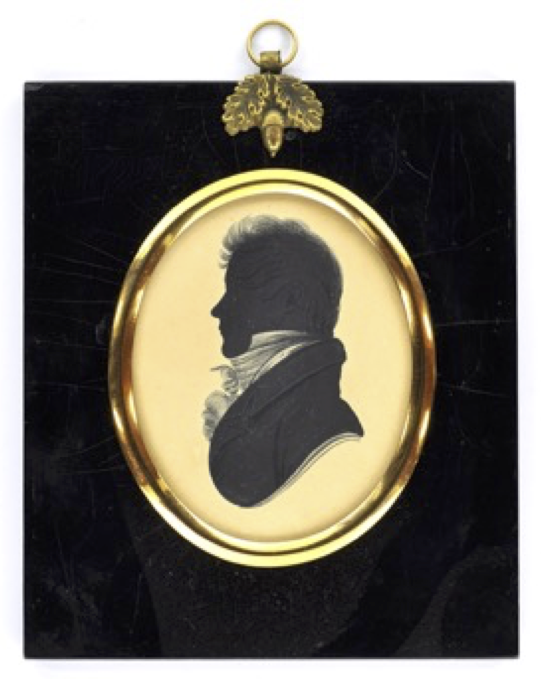
Silhouette portrait of a man facing left by Allport, terminated with his double shadow below the sitter’s bustline. Private Collection
PARENTS
Thomas Allport, born 1749 Wolverhampton - bur.08.08.1832 aged ‘83 yrs’ Aston, Birmingham
Ann Cox, born 1750 Birmingham - bur.09.02.1825 aged ‘75yrs’ Aston, Birmingham.
Thomas was a successful gunsmith and 6 of 7 sons followed in the trade, which was in constant demand during the Napoleonic Wars. Likely instructing his sons, Birmingham Indenture records also show him employing several apprentices during the 1780s and 1790s.
SIBLINGS
7 sons and 4 daughters were born to Thomas and Ann between 1776 and 1798. All were baptised at St Martins, Birmingham.
WILLIAM TWIGG ALLPORT (bapt.11.09.1779 Birmingham. dec.24.06.1831 Liverpool)
WA was Thomas and Ann’s third child and the only offspring christened with the name of a gunsmith, the Twiggs had a well-established business in Birmingham and London. The only son not to become an armsmith, he appeared never to have used his middle name either. Perhaps he had an aversion to the trade or showed an artistic talent which drew him in a different direction.
MARRIAGE/SPOUSE
03.02.1802. WA marries Alice Ashworth (1775-1853) by License at St James Liverpool. Her birthplace and background are unknown. The register shows her to be illiterate. The marriage is the first known record of WA in the city. He lists his occupation as ‘Artist’.
OFFSPRING
Alice bore 10 children between 1803-1819. All were born in Liverpool. Only 3 are known to have reached adulthood. This degree of mortality was unremarkable for the city at that time. When WA’s son John was interred in September 1819, 8 other infants were buried there the same day.
• Elizabeth (1): bapt.25.01.1803. dec. before 1811
• Ann: bapt. 14.08.1804; marr. 23.04.1826; bur.14.01.1842 Liverpool; issue.
• William: born 15.03.1806; marr.23.04.1831; bur.21.01.1874 Anfield; issue.
• Alice: bapt.23.04.1810; dec N/K
• Elizabeth (2): born 09.11.1811; dec N/K
• William “an infant”: bur.29.10.1812. Liverpool.
• Sarah: bapt.17.10.1813; bur.12.06.1851. Liverpool.
• Charles: bapt. 29.01.1816; bur 6.01.1818. Liverpool.
• Samuel Molyneux: 1-13. July 1818. bur. Liverpool.
• John: 8-19. September 1819. bur. Liverpool.
The interment of WA’s sixth child begs a curious question. The register records the burial of William “an infant” son of WA and Alice - however, at the time they already had a six-year-old of the same name who lived till 1874!
CAREER
What drew WA to Liverpool is uncertain. At his marriage in February 1802 and 11 months later at his first child’s baptism registers record him an ‘Artist’. At the following two baptisms in March 1804/06, he’s listed more prosaically a ‘Painter’. What these artistic endeavours were, prior to being engaged by William Bullock’s Museum in the autumn of 1806, remains conjecture.
THEATRE SCENERY PAINTER? (ca. 1795-1806)
Recent research has discovered a possible family link between WA and the eminent Birmingham born watercolourist David Cox {1783-1859). Though evidence is inconclusive, it’s possible WA’s mother Ann Cox (1750-1823) and Joseph (1744-1831), David Cox’s blacksmith father, may have been related. Both were of an age to have been siblings, both lived in Aston, a parish sparsely populated until the 1770’s, and both Joseph Cox and WA’s father supplied arms to the Board of Ordnance.
Bolstering the supposition, mention is made in ‘MEMOIRS OF DAVID COX…’ published in 1873, of a ‘cousin Allport’ who obtained David Cox his first employment ‘…to grind colours and wait on the scenery painters’ at Birmingham’s New Street Theatre, where Cox quickly graduated into a scene painter working in Birmingham and Liverpool before moving to London in 1804.
If WA was indeed ‘cousin Allport’, it can be inferred his connection to the New Street Theatre was strong enough to secure David Cox his first occupation. Furthermore, it’s plausible an occupation as a scene painter may well account for WA’s anonymity as an “artist/painter” before being taken up by Bullock’s Museum at the somewhat advanced age of 27.
Interestingly, the 04.02.1831 LIVERPOOL CHRONICLE obit. for profilist William Kerry (1788-1831), a contemporary of WA, states he was ‘…nearly eighteen years principal artist to the Minor Theatres of Manchester and Liverpool ‘. 2021 research also found a number of other profilists with theatrical links including Mrs Collins, Mrs Hudson , William Jeffreson and Samuel Betts. Doubtless further research will bring others to light.
Intriguingly in 1800, the home of William Bullock’s ‘Celebrated Cabinet of Curiosities’ was Portugal House which was adjacent to the New Street Theatre. With such close proximity, it’s possible when Bullock relocated to Liverpool the following year, WA followed in his wake.
PROFILIST AT BULLOCKS MUSEUM (1806-09)
On less conjectural ground it’s safe to infer WA was engaged as a profilist by the time William Bullock placed an advertisement in the 15.10.1806 LIVERPOOL CHRONICLE, indicating he had ‘…just completed a machine…that would take the most accurate Profile Miniature Likenesses in One Minute. Price of Profiles 2s or neatly shadowed 5s. Specimens may be seen above’ (i.e. at the Church Street museum).
WILLIAM BULLOCK AND HIS MUSEUM
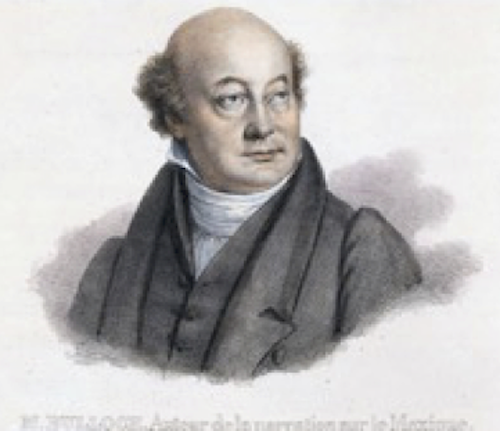
Portrait of William Bullock ca.1825.
In brief William Bullock (1773-1849) and brother George (ca.1777-1818) were two remarkable sons born to Sybilla Bullock (1749-1831) who was herself noteworthy. WB became a discerning, relentless collector of antiquities and “objects of natural history”. George, in turn, was a gifted wax modeller, sculptor and outstanding innovator of furniture design.
Between 1793-99 WB accompanied his mother to various Midland towns exhibiting her ‘GRAND COLLECTION of FIGURES’ a life-size collection of wax figures of Royalty and the newsworthy. Perhaps distressing incidents caused advertisements to regularly advise visitors their dogs would be refused admission….
WB’s first museum opened in Sheffield in 1799, then moved to Portugal House, Birmingham in 1800. Requiring larger premises, he moved to 24 Lord Street Liverpool in 1801, describing himself a ‘Silversmith, Jeweller, Toyman and Statue Figure Manufacturer….’ Ever evolving, the museum moved to the even larger purpose-built ‘NEW EGYPTIAN HALL’ in Church St. in May 1805.
The concern was as much an emporium as a museum. Three advertisements in GORE’S LIVERPOOL and GENERAL ADVERTISER in May 1805 list ‘… a new assortment of every article in the Bronze Figure and Ornamental Business…’ Also on offer were China, Marble and Bronze Tables, Bookcases, Vases, Lamps and Candelabra. Furniture could be altered and ‘…Bronzed in the Present Fashion’. Profiles would be added to the wares the following year.
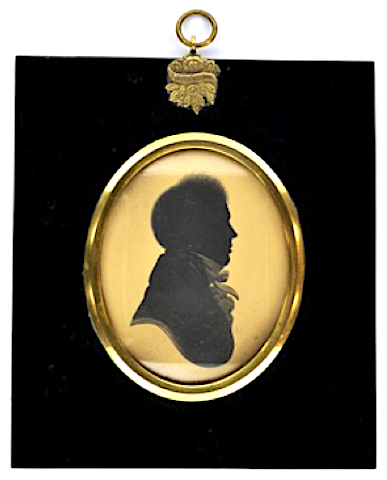
Allport bustlength silhouette portrait of man facing right. Private Collection
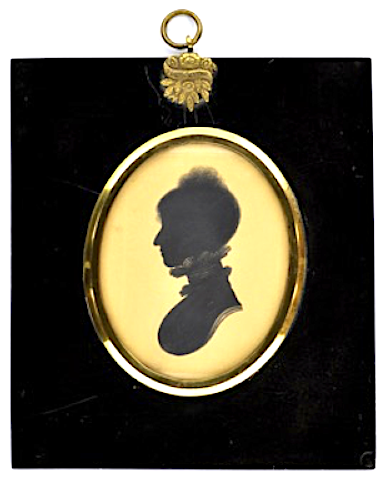
Allport bustlength silhouette portrait of woman facing left. Private Collection
MUSEUM TRADE LABELS
McKechnie (1978) recorded three trade labels. However, 2021 research discovered four. Two share the same wording but differ slightly in typeface and layout. Two others are a simpler design offering less information, one with and one without a ‘corrugated’ surround to the label’s content.
As the museum only offered profiles for two and a half years it’s impossible to gauge without dated labelled works which style of Bullock trade label came first.
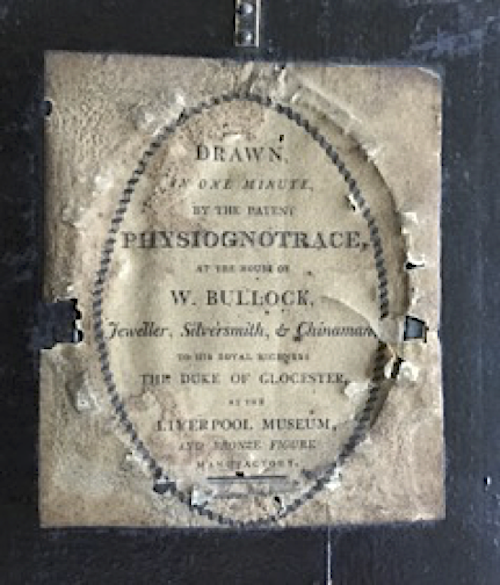
Image showing one of Allport's four trade labels. Private Collection
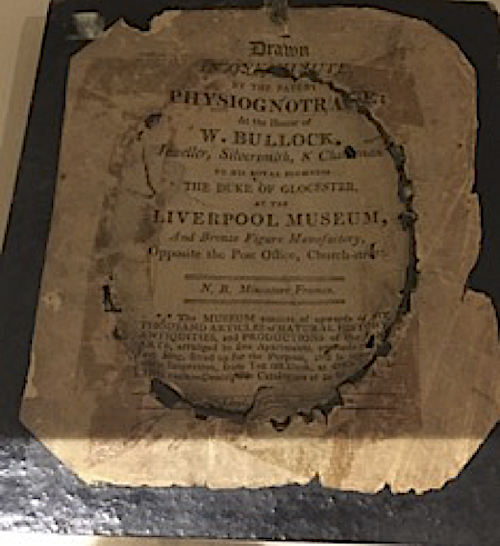
Image showing another of Allport's four trade labels. Private Collection
Bullock also printed a catalogue of his exhibits. It ran to 17 editions. ‘A COMPANION TO Mr BULLOCK’S MUSEUM’ can be accessed online at www.biodiversityheritagelibrary.org The ‘COMPANION…’ also lists exhibit contributors which may prove useful tracing the background of Allport’s named sitters.
WA’s employment ceased in spring 1809 when, deciding to maximise the museum’s profitability, Bullock relocated it to London’s Piccadilly where it opened in June 1809 to enormous and lasting success.
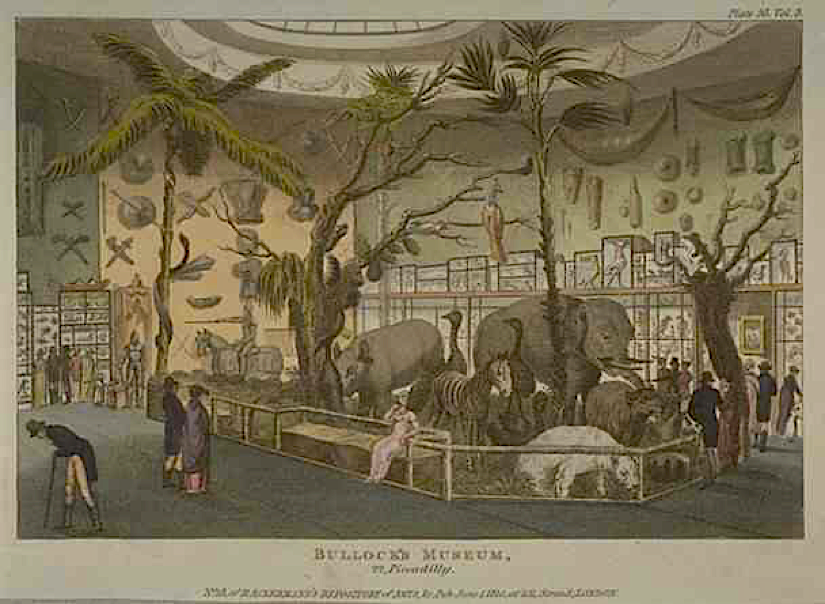
Bullock's museum in Piccadilly, London
FURNITURE BROKER & PROFILIST (1809-ca.1828)
Profile likenesses were not offered at the London venue, so it’s probable, before the museum moved south, its “PHYSIOGNOTRACE” machine was acquired by WA as he certainly used one after 1809, though the quantity of profiles he painted after that date is difficult to quantify. However, it is known that from 1810, Liverpool Directories/Baptismal registers list WA as an ‘ARTIST and FURNITURE BROKER’ of Stanley St.
BELOW: an extremely rare handwritten Allport trade label from March 1813. In the top right WA recorded he charged 5s for the profile and 8s 6d for the frame.
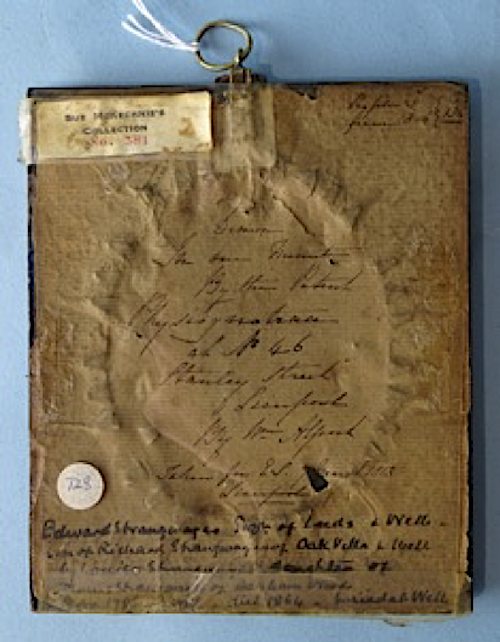
Image courtesy of Eldreds Auctioneers, Plymouth
Living at various addresses there between 1802-29, it transpires Stanley St was the centre of Furniture Broking in Liverpool. In a street of about 80 properties, 50 were listed in the 1816-17 LIVERPOOL COMMERCIAL DIRECTORY as Broker’s premises. Ten years later GORE’S DIRECTORY records 92, 49 of which were in Stanley St.
Generally speaking, Brokers acquired damaged/secondhand furniture, employing cabinet makers, chair makers and painters to repair and refresh stock before selling it on. With a nod to the business, a Broker’s Alley stood at the street’s eastern end and an auctioneer’s, presumably for furniture, was located at 39 Stanley St.
Obviously involved in the business, WA’s son William became a ‘Furniture Painter’ and later married into a family of cabinet makers, while WA’s daughter Ann married a cabinet maker of Stanley St in April 1826.
• 1829. For whatever reason, WA departed Stanley St. after residing there for nearly 30 years. Moving to 3 Russell Place, Bartlam St. north of the city centre, William Jnr is listed ‘head’ of house. Both men are recorded ‘Painters’, presumably of furniture.
• 23.04.1831. WA attends his son’s wedding and signs the register as a witness. Two months later he dies.
DEATH
William Allport ‘Artist of Church Alley’ died 24.06.1831 aged 52 and was buried 3 days later in St. Johns Churchyard.
© Brian Wellings 2022
